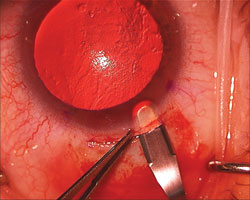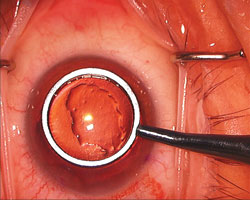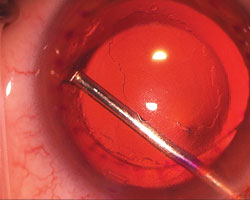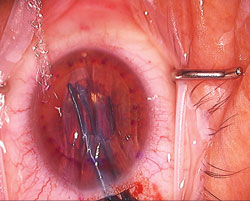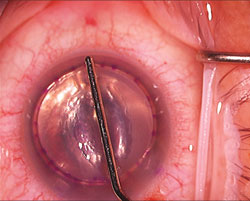Ten tips for successful DSAEK surgery
A clinician attributes a low complication rate to a specific technique for performing Descemet’s stripping automated endothelial keratoplasty.
 Thomas John |
Endothelial keratoplasty has come to the forefront of corneal transplant techniques as a means of quickly restoring sight in most cases of endothelial decompensation. This is clearly changing the way we do corneal transplant surgery, moving away from full-thickness corneal replacement procedures to selective tissue corneal transplantation. Such a change in surgical direction benefits the patient, as we retain those healthy parts of the cornea that do not require replacement. Further, we have progressed from technique-intensive deep lamellar endothelial keratoplasty to technique-simplified Descemet’s stripping automated endothelial keratoplasty. Although Descemet’s membrane endothelial keratoplasty is more “tissue-neutral” (no addition of tissue) and anatomically appealing, DSAEK now appears to be the dominant procedure among corneal surgeons.
In this column, Dr. Terry provides several insights into DSAEK surgery that will benefit all DSAEK surgeons and help in the overall success of this procedure.
Thomas John, MD
OSN Surgical Maneuvers Editor
 Mark A. Terry |
Over the past 5 years, we have used essentially the same surgical technique for DSAEK surgery for over 900 cases with very little modification in technique for complex cases. Eight surgeons at Devers Eye Institute have used the same technique, and the complication rate for each surgeon has been the same, regardless of the level of surgical experience (cornea fellow or attending physician). The dislocation rate in this series of cases is less than 3%, and it is less than 2% for simple Fuchs’ dystrophy cases. The primary graft failure rate is less than 0.5%, and there has been only one case of air bubble-induced pupillary block. It is the specific technique that we have used for DSAEK, rather than the hands of the specific surgeons, that is responsible for this low complication rate.
1. Respect donor endothelium
The primary goal of surgery is to transplant healthy endothelium. Therefore, any maneuver during surgery that causes endothelial trauma should be avoided if at all possible. Any touch and any stretch of the endothelial layer will cause significant damage, and the peripheral endothelial cells are just as important to protect as the central cells. Therefore, the surgeon must critically look at each step of the specific procedure and determine what can be done to better protect the endothelium.
2. Warm donor tissue
Our standard practice with penetrating keratoplasty and all endothelial keratoplasty is to remove the donor tissue container from cold storage at least 2 hours prior to use and allow it to warm to room temperature. This allows the antibiotics in the Optisol (Bausch + Lomb) storage medium to work and the endothelium to become metabolically active more quickly.
3. Use 5-mm scleral access incision
Wound compression during insertion of the tissue is the major cause of endothelial trauma in DSAEK surgery. Large-diameter tissue going through a small wound causes damage directly proportional to the size disparity between the graft and the incision. Laboratory and clinical studies have provided evidence that if the DSAEK incision is 3 mm, there will be more endothelial cell death than if the incision is 5 mm. If the 5-mm wound is scleral in location (Figure 1), then the induced astigmatism is less than 0.25 D, which is less induced astigmatism than after a 3-mm clear corneal incision. The beveled scleral wound heals fully with vascularization and is stronger than a clear corneal wound. Therefore, other than ease of use for the surgeon, there does not appear to be a strong rationale for using clear corneal incisions for DSAEK surgery.
|
Images: John T, Terry MA |
4. Use appropriate size donor
Eyes are different sizes, and one DSAEK donor size does not fit all corneas. The graft size is determined based on the maximum donor size that can be comfortably fitted without the graft edges overlapping the internal openings of the main wound or the two paracentesis wounds (Figure 2). There is no relationship between the graft size and the postoperative 1-, 2- or 3-year endothelial cell counts. Hence, we do not “force” a larger graft into a small eye; otherwise, complications (eg, dislocations, peripheral anterior synechiae) may result. Our most common graft size is 8.5 mm, but we have placed 9-mm grafts on large corneas and a 5-mm graft in an iridocorneal endothelial syndrome eye with extensive peripheral anterior synechiae.
|
|
5. Use cohesive viscoelastic and then remove it
Use of cohesive viscoelastic Healon (sodium hyaluronate, Abbott Medical Optics) for all 900+ DSAEK cases has resulted in the lowest dislocation rate in the world. Healon does not coat surfaces and is easily removed from the eye prior to donor insertion. Therefore, it has no effect on graft adhesion. Healon facilitates scoring and stripping of recipient Descemet’s membrane and scraping the peripheral recipient bed.
6. Perform recipient bed scraping
Scraping the peripheral recipient bed with an instrument designed for that purpose (Figure 3) creates stromal fibrils in the bed that intertwine with donor stromal fibers to enhance adhesion, thus keeping the donor tissue close to the recipient bed until endothelial pump function allows permanent self-adherence. The white fibril band is not subtle; if it is not easily seen with the red reflex during surgery, the bed has not been scraped enough. This quick scraping maneuver has no effect on vision, cannot be detected postoperatively and will decrease the dislocation rate. With no downside, why not try it?
|
|
7. Eliminate eccentric trephinations
Eccentric trephination results in a full-thickness edge of the donor tissue and it can be a disaster for DSAEK surgery. When using the naked eye, it is not possible to consistently trephinate an 8.5-mm donor tissue from a 9-mm bed, executing precise placement with only a 0.25-mm area of peripheral clearance. Without the microscope, one may not be aware of eccentric trephination. With our specific technique, no eccentric trephination has occurred in more than 900 cases (Figure 4).
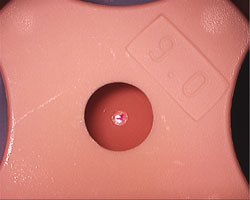 Figure 4a. Looking down trephine. |
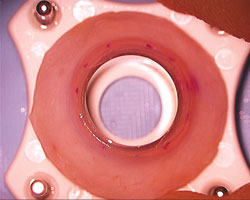 Figure 4b. Centered cut every time. |
8. Use non-coapting forceps
We have used Charlie insertion forceps (Bausch + Lomb) for inserting the folded 60%/40% tissue for all our cases (Figure 5). These non-coapting blade forceps do not meet at the tips, employing a 150-µm separation at the tips to grasp the tissue but not crush it. Once the tissue is inserted, the 60% edge is lined up with the surface template mark, and the chamber is deepened with balanced salt solution on the stromal fold side of the tissue. It is the deepening of the chamber that allows the tissue to start to unfold. Once the tissue is partially unfolded, an air bubble is very slowly injected between the lips of the “taco” and unfolding is completed. At all times, the surgeon knows the orientation of the tissue and no stromal ink marks are needed.
|
|
9. Evacuate interface fluid with surface sweeping
Tissue adhesion is enhanced by getting the donor tissue as much in contact with the recipient bed as possible for as long as possible. Once unfolded and centered, lock the tissue in place with a chamber filled with air and the IOP raised to over 40 mm Hg. Massage the corneal surface from the central cornea to the limbus in every quadrant, “milking” the interface fluid out of the interface and over the edge of the graft with a Cindy Sweeper (Bausch + Lomb) (Figure 6) or other device. If done for at least 1 minute, the interface fluid will be gone and venting incisions will be unnecessary. Venting incisions have been associated with interface infections and interface epithelial ingrowth. If they are not needed, why put the patient at risk? The absence of interface fluid can be verified by a stable graft with no movement on sweeping, small interface bubbles that do not move with sweeping, and visualization of the donor endothelium at high magnification.
|
|
10. Avoid pupillary block
Pupillary block can result in severe visual loss. After interface fluid evacuation, we allow 10 minutes for the graft to settle into place with the chamber filled with air and the IOP elevated above 30 mm Hg. We prevent pupillary block postoperatively by ensuring that only a small, freely floating air bubble remains when the eye is patched (Figure 7). The patient’s face is turned away from the surgeon (ie, nasally for a temporal approach), which places the paracentesis sites in a superior location. The balanced salt solution cannula is then inserted into the anterior chamber and the air-fluid exchange is completed in seconds because the air will float superiorly and exit from the paracentesis site. All of the air is removed from the eye. The graft will not fall off. The head is positioned facing up. Reinjected air is trickled into the eye leaving a 5-mm to 6-mm air bubble, free of the pupillary margin, in the eye. Pressure is normalized with balanced salt solution and the eye is patched. The patient is not examined until the next morning.
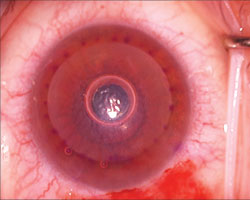 Figure 7a. Nearly all air evacuated. |
 Figure 7b. Final air bubble. |
References:
- Chen ES, Terry MA, Shamie N, Hoar KL, Phillips PM, Friend DJ. Endothelial keratoplasty: vision, endothelial survival, and complications in a comparative case series of fellows vs attending surgeons. Am J Ophthalmol. 2009;148(1):26-31.
- Terry MA, Saad HA, Shamie N, et al. Endothelial Keratoplasty: The influence of insertion techniques and incision size on donor endothelial survival. Cornea. 2009;28(1):24-31.
- Terry MA, Shamie N, Chen ES, et al. Endothelial keratoplasty for Fuchs’ dystrophy with cataract: Complications and clinical results with the new Triple Procedure. Ophthalmology. 2009;116(4):631-9.
- Terry MA, Shamie N, Chen ES, Hoar KL, Friend DF. Endothelial Keratoplasty: A simplified technique to minimize graft dislocation, iatrogenic graft failure and pupillary block. Ophthalmology. 2008;115(7):1179-1186.
- Thomas John, MD, is a clinical associate professor at Loyola University at Chicago and is in private practice in Oak Brook, Tinley Park and Oak Lawn, Ill. He can be reached at 708-429-2223; fax: 708-429-2226; e-mail: tjcornea@gmail.com.
- Mark A. Terry, MD, is director of corneal services at Devers Eye Institute and a professor of clinical ophthalmology at Oregon Health Sciences University in Portland, Ore. He can be reached at 1040 NW 22nd Ave., Portland, OR; 503-413-6223; e-mail: mterry@deverseye.org.
- Disclosures: Dr. John has no financial interest in any aspect of this article. Dr. Terry receives a small royalty from Bausch + Lomb for the instruments he designed for endothelial keratoplasty surgery.

